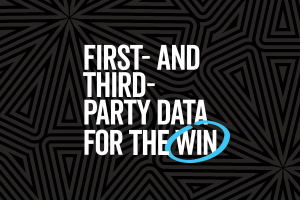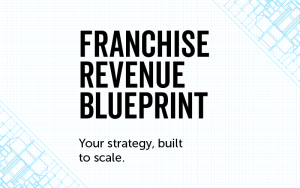To win big at marketing, you need the right type, quality, and combination of data. Let’s explore the benefits of harnessing first- and third-party data for data-driven marketing insights that power even stronger marketing and higher conversions. Here’s your go-to guide to understanding the difference and why both are essential for targeting your best prospects.
What Is First-Party Data?
First-party data is the gold standard of data ownership. It’s the information your business collects directly from your customers and prospects through your own channels. Whether self-reported or captured through your analytics, these demographic and behavioral data points comprise some of the most important metrics you can track. Think of first-party data like a one-to-one conversation with your best prospects that provides details on who they are and what they’re seeking.
Where can you find your first-party data?
- Website audience insights including high-level demographic and behavioral data (e.g., page views, location, device type)
- Website lead intelligence capturing individual user data from tools like LeadsID, as well as form fills
- Purchase history from your e-commerce store
- Responses to your email campaigns
- Social media interactions and private messages
- Customer preferences collected through surveys
What are the benefits of first-party data?
- Control: You’re in the driver’s seat when it comes to collection, storage, and usage.
- Trustworthy: Since you’re the source, you know the data’s accurate, relevant, and up-to-date.
- Privacy-Compliant: It’s easier to maintain compliance with data privacy laws because your customers have knowingly shared this information with you through opt-in methods.
How can you leverage first-party data to amplify your marketing?
- Emails: Personalize email campaigns with customer-specific preferences, including items they recently browsed online or shoes in the size they bought previously. This level of customization strengthens customer loyalty by delivering content that feels relevant and timely.
- Website: Optimize the website user experience (UX) based on visitor behavior. For instance, when you understand how they navigate your site, you can identify areas of friction and remedy them. You can also improve content relevance, page loading speed, and overall design based on their preferences.
- Targeting: Build lookalike audiences based on this data for more accurate ad targeting that resonates with their preferences. Deploy predictive analytics to optimize marketing campaigns and reach these segments.
What Is Third-Party Data?
Third-party data comes from external providers who collect, aggregate, and sell information from a variety of sources. Unlike first-party data, which your business owns, third-party data is acquired from and owned by outside sources. It can range from broad audience trends to highly specific individual insights about your ideal target audience. This data is valuable for expanding audience reach, enriching existing datasets, and enhancing targeting strategies when combined with first-party data.
Where can you find third-party data?
- Demographic data from market research firms.
- Behavioral data collected via cookies from other websites.
- Purchase intent data gathered from retail platforms.
What are the benefits of third-party data?
- Scalable: Access vast amounts of data that would take eons to collect on your own, helping you make more informed marketing decisions.
- Audience Expansion: Reach new segments outside your existing customer base that might be interested in your products or services.
- Cost-Efficient: Tap into data sources without having to build and maintain complex systems to collect your own data.
- Get to Know Your Customer: Learn the relatable traits that make your customer who they are and their purchasing habits. What are their likes/dislikes? What percentage of your customers own a cat, are married, or show interest in sports? Do older customers order more frequently?
How can you leverage third-party data to amplify your marketing?
- Ad Campaigns: Optimize digital ad campaigns to target specific interest groups that have a higher propensity to buy. Provide messaging that resonates.
- CRM: Fill gaps in your CRM data for deeper insights into what your customers are seeking so you can create more meaningful relationships by customizing your email communications.
- Planning: Run market analysis to identify trends and opportunities that might be hidden in the data and use those trends to inform future campaigns.
Why First- and Third-Party Data are Different (and Why You Should Have Both)
Ownership and Source
By its very name, first-party data differs from third-party data in one significant way -where it’s coming from. Since you’re the sole owner of first-party data, you can ensure that it’s reliable and completely tailored to your business. However, since third-party data is shared across multiple buyers, the data is less exclusive, though it provides broader audience insights.
Trust and Accuracy
Let’s get one thing straight: both first-party data and third-party data are trustworthy. However, first-party data is inherently more accurate because it comes directly from your audience, whereas third-party data might not always be 100% accurate, because it’s aggregated from various sources. Even so, you can use both (and trust both) to successfully build an effective targeted marketing campaign.
Scalability
Here’s where the two differ: first-party data is exceptional for understanding and nurturing your current audience, but it can be limited by your direct reach. On the other hand, third-party data provides the reach and volume necessary to scale campaigns and test new markets. That’s its superpower.
Comprehensive Insights
Both types of data work well together to deliver more informed data-driven marketing decisions. When you pair first-party data with third-party data, you build a 360-degree view of your audience. Your first-party data tells you the “who,” “what,” “where,” and “why” about your customers, while third-party data fills in some of the gaps about the broader audience trends for a richer, multi-dimensional understanding.
Enhanced Targeting for Decision Making
When you combine the granular precision of first-party data with the expansive reach of third-party data, you reach next-level targeting. Imagine creating hyper-personalized campaigns that not only reach your ideal customer where they are in their journey but also convert them.
Related: Boosting Direct Mail ROI With Predictive Analytics Tools
We’re Your Data People
At Ironmark, we believe data is more than numbers; it’s the foundation of successful marketing. From data-driven marketing strategies to actionable insights, we’re here to help you harness the power of first- and third-party data to drive real results. Our team can help you with:
- Data-Driven Marketing: Leveraging critical insights, we design physical and digital (phygital) campaigns that target your audience. Intuitive dashboards help you manage the results in real time.
- Lead Intelligence: Our LeadsID tool identifies 40-50% of your website audience by name, email, and mailing address. You can use this information to give your audience exactly what they seek, whether it’s discounts, events, the latest products, or more.
- Predictive Analytics and Data Modeling: We tap first- and third-party data to create campaigns that speak directly to your audience, at the time and in the media that matters most. We can customize content to provide incentives to those who are churning and reinforcement to those who are loyal.
Related: Domino’s Serves Up Sales With Predictive Analytics
With the right data, you can make a definitive difference. Ready to turn your data into smart decisions? Let Ironmark help you harness it to target, convert- and win.




